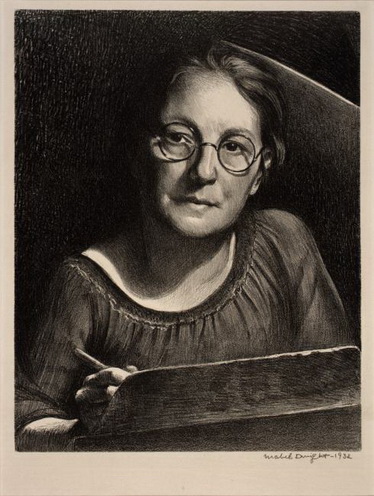 |
Mabel Dwight | |
| Birth Date: January 31, 1875 |
||
| Death Date: September 4, 1955 Artist Gallery |
||
| One of the most notable American lithographers of the 1920s and 1930s, Mabel Dwight is best known for her satirical depictions of contemporary New York life. Dwight, who struggled with increasing hearing loss, was a keen observer of life’s everyday comedic occurrences that bordered on the absurd. Her printmaking established her as a noted artist of the American scene.
Born Mabel Jacque Williamson in Cincinnati, Ohio, an only child, and raised in New Orleans, Dwight moved to San Francisco with her family in 1890 and studied painting at the Mark Hopkins Institute of Art in 1897, now the San Francisco Art Institute. While attending Mark Hopkins, Dwight was introduced to socialism by fellow students, an ideology she remained dedicated to throughout her life and which deeply influenced her art. She became a member of the Sketch Club, the first organization exclusively for women artists in California, which offered opportunities that were previously inaccessible to them. The club, established “to create and encourage in their friends and the public a more general interest in things artistic,” sponsored lectures, sketching trips, and semiannual members’ exhibitions. Dwight exhibited with the Sketch Club in 1897 and in 1898 served as one of its eight directors.
After a year at Mark Hopkins, Dwight was unable to continue her studies and traveled through Egypt, Sri Lanka, India, and Indonesia instead, among other places. She settled in Greenwich Village in 1903, a New York City neighborhood of bohemian artists, writers, and intellectuals. Greenwich Village was supportive of experimental lifestyles, feminism, and socialism, and had available rooms and studios at low rents. Washington Square, in the heart of Greenwich Village, was a popular spot for artists, and Dwight shared 60 Washington Square South with three others — an illustrator, a sculptor, and a painter.
In 1906, Dwight married painter and printmaker Eugene Higgins (1874—1958), taking his last name and spending the next decade actively championing his art and left-wing politics, abandoning her own art career as a result. Their marriage was not easy; they lived in poverty and Higgins was confined to a hospital for months after contracting tuberculosis. The couple met the print dealer Carl Zigrosser in 1913, who tried with little success to sell Higgins’ etchings, but who would end up becoming a driving force in Dwight’s career in the future. In 1917, Dwight and Higgins separated and were divorced by 1921, whereupon Mabel adopted the last name Dwight; its origin is unknown. Zigrosser introduced her to Roderick Seidenberg, architect and author, and by 1917 Dwight and Seidenberg were living together.
Dwight re-entered the art world in 1918 with a job at the Whitney Studio Club, an organization founded to promote modern American art, as receptionist to its director, Juliana Force. The Studio Club would eventually evolve into the present-day Whitney Museum of American Art. While working at the Studio Club, Dwight participated in their drawing classes and entered into their exhibitions alongside fellow artists Isabel Bishop and Peggy Bacon, who were members. One of Peggy Bacon’s works, a drypoint titled Frenzied Effort, even features Dwight in the bottom right corner during a life drawing class at the Studio Club. The American Scene and social satire began to emerge in Dwight’s work, influenced by her time at the Studio Club. |
||


